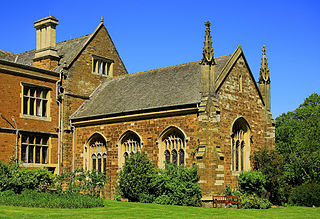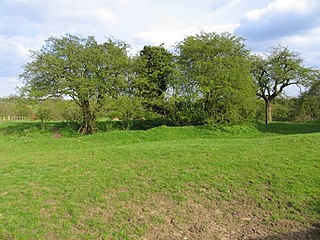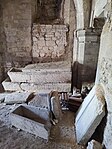
Spinney Abbey, originally known as Spinney Priory, is a house and farm on the site of a former monastic foundation close to the village of Wicken, on the edge of the fens in Cambridgeshire, England.
William de Lode, also known as William Gilbert, was the Prior of Spinney Abbey in Cambridgeshire from 1390 to 1403. He is recorded as having been fatally stabbed at his place of worship.

Merton Priory was an English Augustinian priory founded in 1114 by Gilbert Norman, Sheriff of Surrey under King Henry I (1100–1135). It was situated within the manor of Merton in the county of Surrey, in what is today the Colliers Wood area in the London Borough of Merton.

Leiston Abbey outside the town of Leiston, Suffolk, England, was a religious house of Canons Regular following the Premonstratensian rule, dedicated to St Mary. Founded in c. 1183 by Ranulf de Glanville, Chief Justiciar to King Henry II (1180-1189), it was originally built on a marshland isle near the sea, and was called "St Mary de Insula". Around 1363 the abbey suffered so much from flooding that a new site was chosen and it was rebuilt further inland for its patron, Robert de Ufford, 1st Earl of Suffolk (1298-1369). However, there was a great fire in c. 1379 and further rebuilding was necessary.

Barnwell is a suburb of Cambridge in England. The population of the Barnwell ward of Cambridge City Council at the 2011 census was 1,967. It lies northeast of the city, with Cambridge Airport located immediately to the east. It forms part of the ecclesiastical parish of St Andrew the Less and was the site of Barnwell Priory.
The Prior of Loch Leven was the head of lands and of the community Augustinian canons of St Serf's Inch Priory, Loch Leven. There was a Scottish Céli Dé establishment there in the first half of the 12th century, allegedly found by Bruide, son of Dargart, King of the Picts (696–706). When the Augustinian priory was founded in 1150, the Scottish monks were absorbed into the established and those who refused to join were to be expelled. Not all of the priors are known. The most famous prior undoubtedly was the chronicler, Andrew de Wyntoun. Following more than four centuries of Augustinian monastic life and the resignation of the last prior, the Protestant king, James VI of Scotland, granted the priory to St Leonard's College, St Andrews.

John Willis Clark, sometimes J. W. Clark, was an English academic and antiquarian.
The Priory of St Mary, Huntingdon was an Augustinian Priory in Huntingdonshire, England.
Marmont Priory was a priory for Gilbertine Canons in Cambridgeshire, England. It was established by landowner Ralph de Hauvill as a small priory or chantry of three canons who prayed for the souls of de Hauvill and his wife, Maud. Fifteen years earlier, Maud had a vision of Gilbert of Sempringham ascending to Heaven on the day of his death.
Stonely Priory was an Augustinian priory in Cambridgeshire, England. It was dissolved in 1536.

Kirby Bellars Priory was a small priory of Canons Regular of Saint Augustine in Leicestershire, England. It is now the Church of England Parish Church of Saint Peter's serving the village of Kirby Bellars.

Launde Priory is a former Augustinian priory in Leicestershire, England. Its successor Launde Abbey is used as a conference and retreat centre by the Church of England dioceses of Leicester and Peterborough.

Sempringham Priory was a priory in Lincolnshire, England, located in the medieval hamlet of Sempringham, to the northwest of Pointon. Today, all that remains of the priory is a marking on the ground where the walls stood and a square, which are identifiable only in aerial photos of the vicinity. However, the parish church of St Andrew's, built around 1100 AD, is witness to the priory standing alone in a field away from the main road.
Hickling Priory was an Augustinian priory located in Norfolk, England.
Picot of Cambridge was a Norman landowner and Sheriff of Cambridgeshire.

Brooke Priory was a minor house of Augustinian monks in Brooke, Rutland. It was a cell of St Mary's Abbey, Kenilworth.

The Church of St Giles is a Grade II*-listed church in Cambridge, England. It is a Church of England parish church in the Parish of the Ascension of the Diocese of Ely, located on the junction of Castle Street and Chesterton Road. It was completed and consecrated by the Bishop of Ely in 1875, to replace an earlier church founded in 1092. The church, which added "with St Peter" to its appellation when the neighbouring St Peter's Church became redundant, is home to both an Anglican and a Romanian Orthodox congregation and is used as a venue for concerts and other events. The church is kept open daily for visitors.

Abbey House or Old Abbey House is a 17th-century house on the corner of Beche Road and Abbey Road in Abbey, Cambridge. It lies just to the east of the roundabout where Elizabeth Way and Newmarket Road meet. The house is 17th-century but perhaps containing parts of earlier date; it has two storeys with attics. The house is a Grade II listed building; the walls and archway are separately listed Grade II. It has been described as both the oldest inhabited house and the most haunted house in the city.

St Mary and St John Church is a Church of England parish church in the village of Hinxton in Cambridgeshire.


















